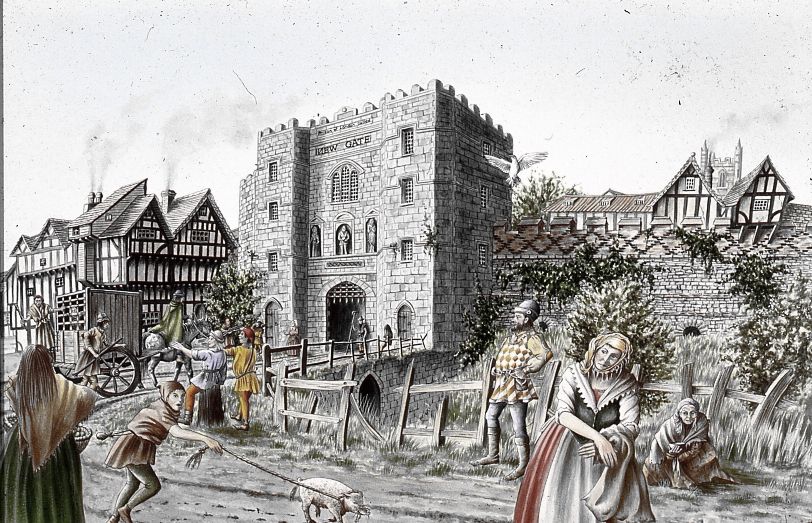
The day began with the King and advisors sheltering in the Tower of London, as the rebels approached London. The King took 4 or 5 ships to Greenwich, to attend a parley with the rebels. The men of Kent descended from Blackheath on the South Side and those from Essex came to the River on the North side. The King’s advisors told him it was too dangerous to meet the rebels. So, he retreated to the Tower of London.
The Kentish rebels marched on Soutwark, opening the Marshelsea prison, and targeting properties in Southwark to ransack. They persuaded the Warden of London Bridge to let down the drawbridge and the rebels poured into the City of London. Outside the Aldgate (the home of Geoffrey Chaucer and his wife) rebels from Essex clamoured to be let into the City of London. Allies from inside the Walls, helped persuade the Warden of the Gate, William Tonge, to open it.
The rebels attacked and burnt St Johns of Jerusalem, the Knights’ Hospitalers monastery in Clerkenwell. The prior was Robert Hales, the Treasurer of England and on the list of people the rebels wanted executed for his part in imposing the Poll Tax; and running a system which used the law to keep the working class in subjection. The Fleet and Newgate Prison were attacked and prisoners released.
Prisons were a particular target because following the huge death rate in the Black Death of 1348, workers were legally required to work at pay rates predating the plague. With the shortage of labour, wages had gone up, and the ruling classes were using the legal system to stop workers benefitting from the shortage of labour. Punishment could include branding and imprisonment. This was still continuing 40 years after the Black Death!
Chaucer is an example of how the law was being used oppressively. He was accused of kidnapping a cook, Cecily Chaumpagne, from her rightful employer. It turns out that she was jointly accused with the poet of breaking the Statue of Labourers. So a cook and her new employer could be taken to the law for simply changing jobs. The ‘Peasants’ (who included not only agricultural workers, but also artisans, and even gentlemen) freed prisoners from unfair imprisonment. (see my post on this episode here)
On the 13th, the rebels also attacked the Temple, burning legal records, and attacked the magnificent Savoy Palace. This was the home of the Duke of Lancaster, the formidable John Of Gaunt, the real ruler of the country. Richard II was his nephew, and was 14 at the time. So the rebels did not blame him for the problems of the Government.
The problems included setbacks in the 100 Year War with France, as the gains of Edward III were progressively lost. In order to retrieve the situation, a series of taxes, particularly poll taxes, were levied. The rich paid the same as the poor. But the revolt only broke out when the Government realised that the 1381 tax was not bringing in so much money as the previous taxes. It became clear that a large number of tax payers had disappeared since the last tax. Commissioners were set out into Essex to find the arrears. They were attacked by the people, and the Revolt began.
John of Gaunt was in Scotland, and the King had no body of troops to impose order. in the evening with fires burning all around London, Rebels gathered outside the Tower of London. The King and his advisors were trapped inside. Rochester Castle had previously fallen to the Peasants, and so a plan was made to lure the rebels away, and allow the hated Robert Hales, and the Chancellor of England Archbishop Sudbury of Canterbury to escape.
What would the morning bring?
To be continued.
First published, in haste, on June 13th 2025

France had a big ‘Peasant’s revolt in the summer of 1358.
These revolts were called ‘Jacqueries’ , the word originates from ‘jacques” the short jacket peasants wore.